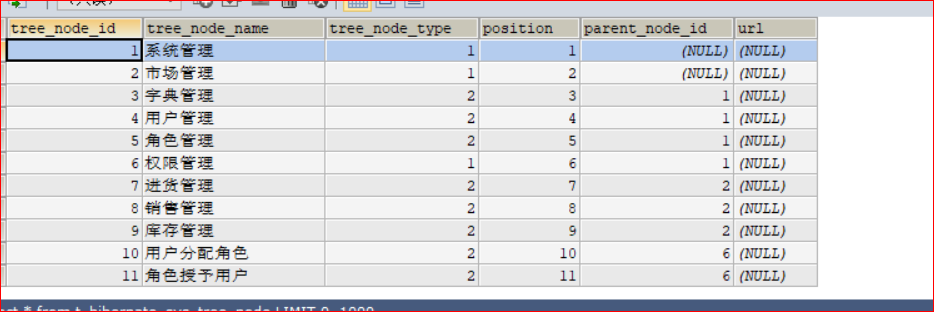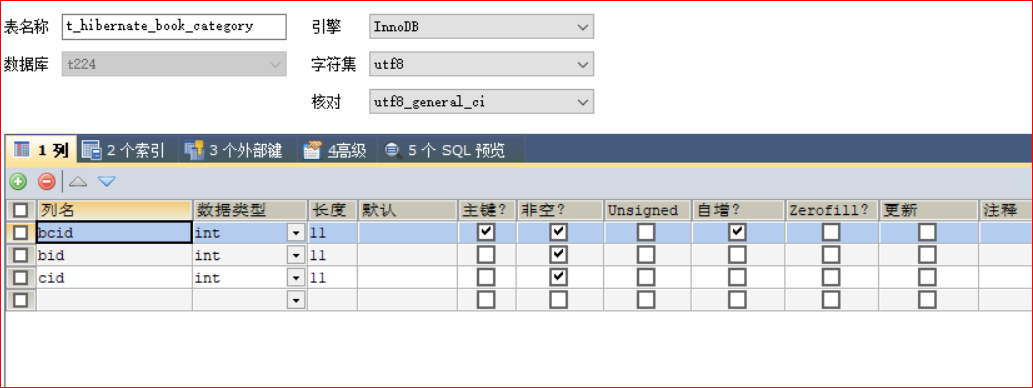一对多自关联(说白了就是自己关联自己)比如:
商城里面的分类,一级分类:电器,家具等等。
电器下面分二级分类:厨房电器,生活电器等等。
二级分类厨房电器下的三级分类:电压力锅,电磁炉等等。。
数据库:

实体类:(TreeNode)
package com.chenjiahao.four.entity;
import java.util.HashSet;
import java.util.Set;
public class TreeNode {
private Integer nodeId;
private String nodeName;
private Integer treeNodeType;
private Integer position;
private String url;
private TreeNode parent;
private Set<TreeNode> children = new HashSet<TreeNode>();
private Integer initChildren = 0;
//0懒加载 1、强制加载(子节点)2、强制加载用户 3、强制加载两个
public Integer getNodeId() {
return nodeId;
}
public void setNodeId(Integer nodeId) {
this.nodeId = nodeId;
}
public String getNodeName() {
return nodeName;
}
public void setNodeName(String nodeName) {
this.nodeName = nodeName;
}
public Integer getTreeNodeType() {
return treeNodeType;
}
public void setTreeNodeType(Integer treeNodeType) {
this.treeNodeType = treeNodeType;
}
public Integer getPosition() {
return position;
}
public void setPosition(Integer position) {
this.position = position;
}
public String getUrl() {
return url;
}
public void setUrl(String url) {
this.url = url;
}
public TreeNode getParent() {
return parent;
}
public void setParent(TreeNode parent) {
this.parent = parent;
}
public Set<TreeNode> getChildren() {
return children;
}
public void setChildren(Set<TreeNode> children) {
this.children = children;
}
public Integer getInitChildren() {
return initChildren;
}
public void setInitChildren(Integer initChildren) {
this.initChildren = initChildren;
}
// @Override
// public String toString() {
// return "TreeNode [nodeId=" + nodeId + ", nodeName=" + nodeName + ", treeNodeType=" + treeNodeType
// + ", position=" + position + ", url=" + url + ", children=" + children + "]";
// }
@Override
public String toString() {
return "TreeNode [nodeId=" + nodeId + ", nodeName=" + nodeName + ", treeNodeType=" + treeNodeType
+ ", position=" + position + ", url=" + url + "]";
}
}
TreeNode.hbm.xml
<?xml version="1.0" encoding="UTF-8"?>
<!DOCTYPE hibernate-mapping PUBLIC
"-//Hibernate/Hibernate Mapping DTD 3.0//EN"
"http://www.hibernate.org/dtd/hibernate-mapping-3.0.dtd">
<hibernate-mapping>
<class name="com.chenjiahao.four.entity.TreeNode" table="t_hibernate_sys_tree_node">
<id name="nodeId" type="java.lang.Integer" column="tree_node_id">
<generator class="increment" />
</id>
<property name="nodeName" type="java.lang.String"
column="tree_node_name">
</property>
<property name="treeNodeType" type="java.lang.Integer"
column="tree_node_type">
</property>
<property name="position" type="java.lang.Integer"
column="position">
</property>
<property name="url" type="java.lang.String"
column="url">
</property>
<many-to-one name="parent" class="com.chenjiahao.four.entity.TreeNode" column="parent_node_id"/>
<set name="children" cascade="save-update" inverse="true">
<key column="parent_node_id"></key>
<one-to-many class="com.chenjiahao.four.entity.TreeNode"/>
</set>
</class>
</hibernate-mapping>
在主配置文件/hibernate.cfg.xml中加:
<!-- 一对多自关联 -->
<mapping resource="com/chenjiahao/four/entity/TreeNode.hbm.xml"/>
TreeNodeDao层
package com.chenjiahao.four.dao;
import org.hibernate.Hibernate;
import org.hibernate.Session;
import org.hibernate.Transaction;
import com.chenjiahao.four.entity.TreeNode;
import com.chenjiahao.two.util.SessionFactoryUtils;
public class TreeNodeDao {
public TreeNode load(TreeNode treeNode) {
Session session = SessionFactoryUtils.openSession();
Transaction transaction = session.beginTransaction();
TreeNode t = session.load(TreeNode.class, treeNode.getNodeId());
if(t != null && new Integer(1).equals(treeNode.getInitChildren())) {
Hibernate.initialize(t.getChildren());
Hibernate.initialize(t.getParent());
}
transaction.commit();
session.close();
return t;
}
}
TreeNodeDaoTest测试:
package com.chenjiahao.four.dao;
import org.junit.Test;
import com.chenjiahao.four.entity.TreeNode;
public class TreeNodeDaoTest {
private TreeNodeDao treeNodeDao = new TreeNodeDao();
// @Before
// public void setUp() throws Exception {
// }
//
// @After
// public void tearDown() throws Exception {
// }
@Test
public void testLoad() {
TreeNode treeNode = new TreeNode();
treeNode.setNodeId(6);
treeNode.setInitChildren(1);
TreeNode t = this.treeNodeDao.load(treeNode);
//拿到当前节点
System.out.println(t);
//拿到当前节点的父节点
System.out.println(t.getParent());
//拿到当前节点的 子节点
System.out.println(t.getChildren());
}
}
多对多
数据库的多对多:
数据库中不能直接映射多对多
处理:创建一个桥接表(中间表),将一个多对多关系转换成两个一对多
注:数据库多表联接查询,永远就是二个表的联接查询
hibernate的多对多:
hibernate可以直接映射多对多关联关系(看作两个一对多)
多对多关系注意事项:一定要定义一个主控方
书本表:t_hibernate_book;
书本类别表:t_hibernate_category;
中间表: t_hibernate_book_category;
t_hibernate_book;

t_hibernate_category;

t_hibernate_book_category

实体类和xml配置:
Book:
public class Book implements Serializable{
// book_id int primary key auto_increment,
// book_name varchar(50) not null,
// price float not null
private Integer bookId;
private String bookName;
private Float price;
}
Category:
public class Category implements Serializable{
// category_id int primary key auto_increment,
// category_name varchar(50) not null
private Integer categoryId;
private String categoryName;
private Set<Book> books = new HashSet<Book>();
}
incerse在下面book.hbm.xml和Category.hbm.xml里面都体现了,incerse主要是维护中间表。
book.hbm.xml inverse=false
category.hbm.xml inverse=false
数据添加正常
书籍表、书籍类别关联表各新增一条数据
book.hbm.xml inverse=true
category.hbm.xml inverse=true
只增加书籍表数据
书籍类别关联表不加数据
原因:双方都没有去维护关系
Category.hbm.xml
<?xml version="1.0" encoding="UTF-8"?>
<!DOCTYPE hibernate-mapping PUBLIC
"-//Hibernate/Hibernate Mapping DTD 3.0//EN"
"http://www.hibernate.org/dtd/hibernate-mapping-3.0.dtd">
<hibernate-mapping>
<class name="com.chenjiahao.four.entity.Category" table="t_hibernate_category">
<id name="categoryId" type="java.lang.Integer" column="category_id">
<generator class="increment" />
</id>
<property name="categoryName" type="java.lang.String"
column="category_name">
</property>
<set table="t_hibernate_book_category" name="books" cascade="save-update" inverse="false">
<key column="cid"></key>
<many-to-many column="bid" class="com.chenjiahao.four.entity.Book"></many-to-many>
</set>
</class>
</hibernate-mapping>
book.hbm.xml
<?xml version="1.0" encoding="UTF-8"?>
<!DOCTYPE hibernate-mapping PUBLIC
"-//Hibernate/Hibernate Mapping DTD 3.0//EN"
"http://www.hibernate.org/dtd/hibernate-mapping-3.0.dtd">
<hibernate-mapping>
<class name="com.chenjiahao.four.entity.Book" table="t_hibernate_book">
<cache usage="read-only" region="com.zking.five.entity.Book"/>
<id name="bookId" type="java.lang.Integer" column="book_id">
<generator class="increment" />
</id>
<property name="bookName" type="java.lang.String"
column="book_name">
</property>
<property name="price" type="java.lang.Float"
column="price">
</property>
<!--
table:代表的是中间表
name:书籍的关联属性
inverse:中间表交于对方维护
key:当前类对应的表列段在中间表(t_hibernate_book_category)中的外键bid
many-to-many:
column:对应的是上面key查出来中间表(t_hibernate_book_category)另一个字段cid,当作关联表的主键(category_id)进行查询
class:上述查出来的主键对应的实体类
流程:
以查询book_id=1西游记这本书为例
1、通过建模反射自动生成sql,可以拿到book_id这条记录的基本信息{book_id=1,book_name=西游记,book_price=50}
2、book_id=1->bid=1去查询中间表t_hibernate_book_category,拿到了cid=1,2
3、cid=1,2->t_hibernate_category的category_id=1,2
4、拿到当前book实列对应的categroy的集合
5、最终{book_id=1,book_name=西游记,book_price=50}->
{book_id=1,book_name=西游记,book_price=50,category=[categoryId=2, categoryName=神话], Category [categoryId=1, categoryName=古典]]}
-->
<set table="t_hibernate_book_category" name="categories" cascade="save-update" inverse="false">
<!-- one -->
<key column="bid"></key>
<!-- many -->
<many-to-many column="cid" class="com.chenjiahao.four.entity.Category"></many-to-many>
</set>
</class>
</hibernate-mapping>
在主配置文件/hibernate.cfg.xml中加:
<!-- 多对多的自关联 -->
<mapping resource="com/chenjiahao/four/entity/Book.hbm.xml"/>
<mapping resource="com/chenjiahao/four/entity/Category.hbm.xml"/
dao层:
package com.chenjiahao.four.dao;
import java.util.HashMap;
import java.util.List;
import java.util.Map;
import org.hibernate.Hibernate;
import org.hibernate.Session;
import org.hibernate.Transaction;
import org.hibernate.query.Query;
import com.chenjiahao.four.entity.Book;
import com.chenjiahao.four.entity.Category;
import com.chenjiahao.two.util.SessionFactoryUtils;
import antlr.StringUtils;
public class BookDao {
public Integer addBook(Book book) {
Session session = SessionFactoryUtils.openSession();
Transaction transaction = session.beginTransaction();
Integer bid = (Integer) session.save(book);
transaction.commit();
session.close();
return bid;
}
public Integer addCategory(Category category) {
Session session = SessionFactoryUtils.openSession();
Transaction transaction = session.beginTransaction();
Integer cid = (Integer) session.save(category);
transaction.commit();
session.close();
return cid;
}
public Category getCategory(Category category) {
Session session = SessionFactoryUtils.openSession();
Transaction transaction = session.beginTransaction();
Category c = session.get(Category.class, category.getCategoryId());
transaction.commit();
session.close();
return c;
}
public Book getBook(Book book) {
Session session = SessionFactoryUtils.openSession();
Transaction transaction = session.beginTransaction();
Book b = session.get(Book.class, book.getBookId());
if (b != null && new Integer(1).equals(book.getInitCategories())) {
Hibernate.initialize(b.getCategories());
}
transaction.commit();
session.close();
return b;
}
public void delBook(Book book) {
Session session = SessionFactoryUtils.openSession();
Transaction transaction = session.beginTransaction();
session.delete(book);
transaction.commit();
session.close();
}
public void delCategory(Category category) {
Session session = SessionFactoryUtils.openSession();
Transaction transaction = session.beginTransaction();
Category c = session.get(Category.class, category.getCategoryId());
if(c!=null) {
for (Book b : c.getBooks()) {
// 通过在被控方通过主控方来解除关联关系,最后被控方再做删除
b.getCategories().remove(c);
}
}
session.delete(c);
transaction.commit();
session.close();
}
}
测试:
package com.chenjiahao.four.dao;
import org.junit.Test;
import com.chenjiahao.four.entity.Book;
import com.chenjiahao.four.entity.Category;
public class BookDaoTest {
private BookDao bookDao = new BookDao();
@Test
public void testGetBook() {
Book book = new Book();
book.setBookId(1);
book.setInitCategories(1);
Book b = this.bookDao.getBook(book );
System.out.println(b.getBookName());
System.out.println(b.getCategories());
}
/**
* book.hbm.xml inverse=false
* category.hbm.xml inverse=true
* 数据添加正常
* 书籍表、桥接表各新增一条数据
*/
@Test
public void test1() {
Book book = new Book();
book.setBookName("00咖啡店说课稿5");
book.setPrice(10f);
Category category = new Category();
category.setCategoryId(1);
// 直接将category对象加入到新建的book中是错误的,因为此时的category是临时态的,hibernate是不会管理的
// book.getCategories().add(category);
//将数据库里面的类别数据查找出来
Category c = this.bookDao.getCategory(category);
// c.getBooks().add(book);
book.getCategories().add(c);
this.bookDao.addBook(book);
}
/**
* book.hbm.xml inverse=true
* category.hbm.xml inverse=true
* 只增加书籍表数据
* 桥接表不加数据
* 原因:双方都没有去维护关系
*/
@Test
public void test2() {
Book book = new Book();
book.setBookName("斗宗强者");
book.setPrice(10f);
Category category = new Category();
category.setCategoryId(5);
Category c = this.bookDao.getCategory(category);
book.getCategories().add(c);
this.bookDao.addBook(book);
// c.getBooks().add(book);
}
}